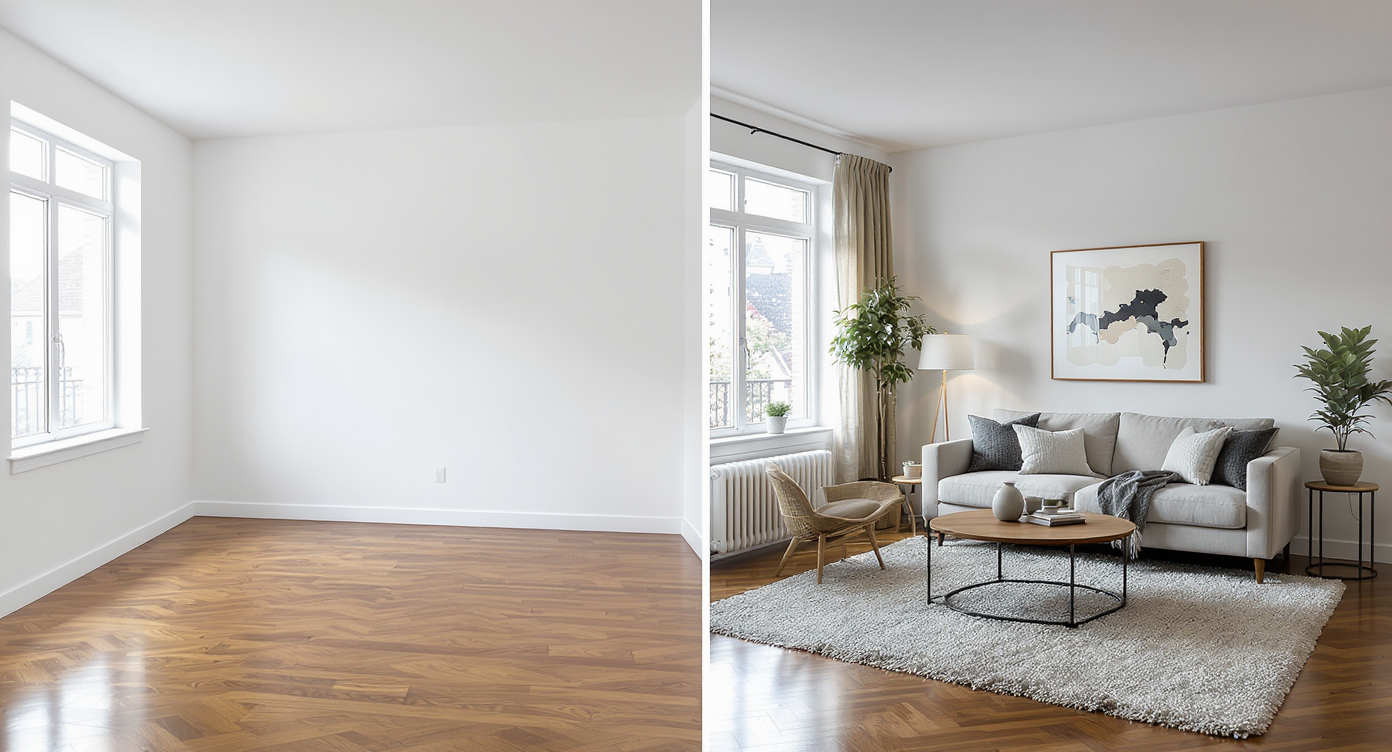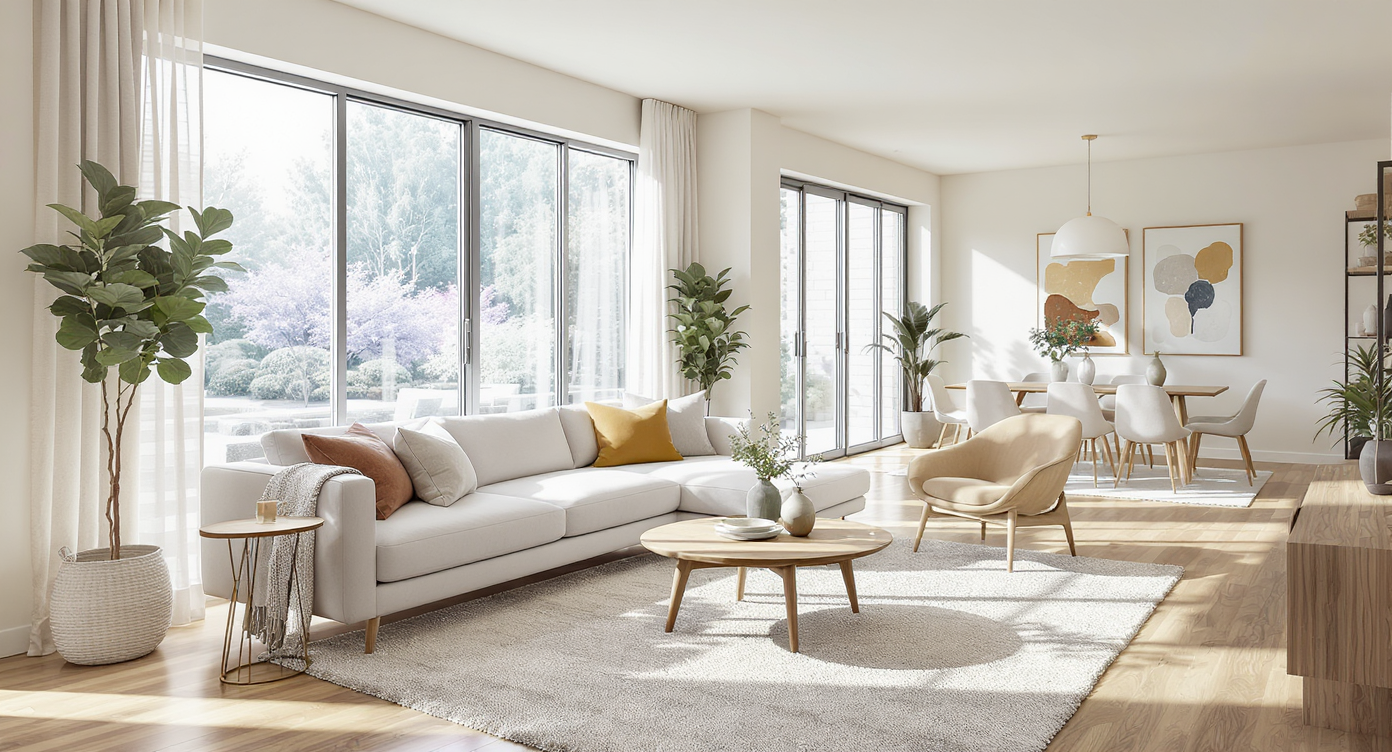TL;DR
Virtual staging for real estate listings works when it adds scale-accurate furnishings and clear disclosure. It goes too far when permanent features, room sizes, or views are altered. Pair every virtually staged photo with the original, label it on-image, and keep the edits realistic.
SEO intro

See the power of virtual staging — from a blank canvas to a beautifully imagined home. The same room, re-envisioned with design and warmth.
In today’s scroll-speed housing market, listing photos sell the story before a showing ever happens. That’s why virtual staging has exploded: it’s faster than bringing in a truck of furniture and it costs a fraction of traditional staging. Agents often report double‑digit lifts in online engagement when empty rooms are styled with scale-accurate furniture. Here’s the thing: when does virtual staging go too far? Homebuyers today expect transparency. Market analysts suggest that misleading listing visuals damage trust, elongate days on market, and increase price reductions. The goal is inspiration, not illusion.
Where the ethical line is in virtual staging
Homes with virtual staging get more clicks when the edits remain faithful to the property, according to agents who track listing performance. Virtual staging—done right—adds furniture, rugs, lamps, and art to show scale and flow. It should never remove or alter fixed elements: heaters, outlets, windows, doors, ceiling heights, beams, trim, floor patterns, or exterior views. Many MLSs require that every altered image be clearly labeled “virtually staged” on the image itself and in the caption. Buyers should be able to reconcile the staged photo with the unedited photo and the floor plan without mental gymnastics. What’s acceptable:
- Adding furnishings and decor that match the home’s style and price point.
- Subtle color harmonizing that resembles a repaint you could complete in a weekend (and disclose it’s a visualization).
- Lighting correction that reflects what a well-exposed camera would capture in person.
- On-image labels and paired “before” photos for every virtually staged scene.
- Deleting baseboard heaters, attic or closet doors, electrical outlets, cable jacks, or vents.
- Reshaping windows or shrinking doors; shifting ceiling slopes; lowering floors; changing tile or hardwood species.
- Inventing views (a lake, forest, skyline) that don’t exist.
- Scaling furniture unrealistically small to make rooms look larger.
Anecdote
A downtown condo launched with cleverly shrunk furniture that made a tight living area feel generous online. After an awkward open house, the team swapped in scale-accurate staging, added a labeled floor plan, and reinstated buyer confidence—proof that honesty sells faster than tricks.
Common mistakes that push virtual staging too far
Over-editing erodes buyer confidence and can keep a listing on market longer, agents say.
- Deleting fixed features. Removing heaters, outlets, or access panels implies they don’t exist. Fix it: keep them visible, or place furniture realistically so they’d still be inferable.
- Resizing furniture to mislead. A “king bed” that fits only by breaking the laws of geometry misrepresents room size. Fix it: use scale-true models and include dimensions on the floor plan.
- Inventing finishes. Swapping busy tile for quiet stone in photos misleads. Fix it: if you’re testing finish ideas, label it clearly as a design concept and show the current finish in the next frame.
- Fake views and landscaping. Adding lakes, forests, or city lights that aren’t there is deceptive. Fix it: limit edits to interiors; if you must visualize landscaping, keep it obviously conceptual and fully disclosed.
- Skipping disclosure. “Virtually staged” belongs on every edited frame, not just in the description. Fix it: add an on-image watermark plus a caption note and include the original photo side by side.
Pro tips agents and photographers use to keep it honest
Experts recommend designing for the medium buyers actually use: their phones, where 80%+ of listing views happen in many markets.
- Stage for mobile first. Keep compositions clean with one focal point per image; busy vignettes shrink poorly on small screens.
- Pair every staged photo with the original. A two-slide carousel (real, then staged) reduces confusion and keeps you compliant with strict MLS rules.
- Use scale locks. Photographers and editors should verify bed sizes, sofa widths, and standard clearances (30–36 inches for walkways; 18 inches around beds) to keep staging honest.
- Add measurements and a floor plan. A labeled 2D plan or quick scan helps buyers translate photos to reality. Homes with floor plans get more qualified inquiries, according to broker analytics.
- Be neighborhood-appropriate. Market analysts suggest that matching furniture style to the property’s era and price point increases saves and shares.
- Watermark clearly. “Virtually staged” should be visible but unobtrusive in a corner; repeat in the caption for accessibility.
- Document everything. Keep a folder with originals, staged versions, and a change log. It protects you if questions arise.
Real stories from the field
True-to-life visuals build trust; deceptive visuals backfire—fast.
- The missing pool. A suburban listing led with a backyard “pool” hero shot that turned out to be a simulated concept. Once buyers realized the pool didn’t exist, showings dropped off and the sellers had to pivot to an accurate marketing set. Lesson: concepts belong in a clearly labeled render, not as the lead photo.
- The invented lake view. A cottage was virtually staged with an expansive lakescape beyond the kitchen window. There was no lake. After complaints, the brokerage replaced the photos and the home sat for weeks, ultimately taking a price cut. Lesson: never invent views; buyers will check Google Maps before they book a tour.
- The shrinking furniture trick. An “urban studio” featured a king bed, sectional, and dining set—all perfectly comfy in photos. At the open house, the space felt half that size. The team restaged with scale-accurate pieces and added a floor plan; inquiries improved and the unit went under contract. Lesson: scale isn’t a design choice, it’s a measurement.
- The vanished baseboard heaters. In an older home, virtual staging hid baseboard heat and an attic access. Sharp-eyed buyers noticed and questioned what else was edited. The agent re-uploaded with clear labels and paired originals, salvaging credibility. Lesson: show the bones; don’t rewrite them.
- ReimagineHome for fast, style-appropriate virtual staging with guardrails that keep fixed features intact.
- Matterport or mobile 3D scans for honest context; CubiCasa for quick floor plans.
- Canva or Lightroom for basic, non-deceptive photo corrections.
- Styldod and similar services for compliant, disclosure-forward staging sets.
- Alt text: “Empty living room followed by the same room virtually staged with scale-accurate sofa and rug.” Caption: “Real photo and virtually staged version; furnishings added, no structural changes.”
- Alt text: “Bedroom with baseboard heater visible; second image shows same room with virtual bed and lamps.” Caption: “Original paired with virtual staging; fixed features remain visible.”
Visualization Scenario
Picture a buyer scrolling on her phone. First image: the real, empty great room. Swipe: a tasteful, virtually staged version with a full-size sectional, 36-inch walkways, and the same heater and outlets visible. She doesn’t feel hustled—she feels oriented. She saves the listing and books a tour.
FAQ
How much does virtual staging cost for real estate listings, and what’s typical for turnaround?
Virtual staging for real estate listings typically costs $25–$150 per photo with 24–72 hour turnaround. Bulk sets and rush delivery increase price.
Is virtual staging worth it for agents in a slow market?
Yes—agents often see 20–40% more online views when rooms are staged, and staging research suggests perceived value can rise 1–5%. The key is ethical, clearly disclosed edits.
What can’t I change with virtual staging if I want compliant listing photos?
Don’t alter fixed features: windows, doors, ceiling height, beams, outlets, vents, heaters, flooring, or exterior views. Keep virtual staging limited to furniture, rugs, lamps, and art.
How should I disclose virtually staged photos on the MLS and portals?
Add a visible “virtually staged” watermark on each edited image and repeat the note in the caption. Pair every virtual scene with the original photo to avoid confusion.
Can buyers tell if photos are virtually staged, and does it hurt trust?
Buyers can accept virtual staging when it’s labeled and realistic. Trust suffers when edits remove features or misstate size, so keep staging truthful and scale-accurate.
Think like a storyteller, not a magician
Let’s be real: buyers don’t expect perfection, but they do expect honesty. Virtual staging can turn cold rooms into warm stories, highlight flow, and help clients envision life there. The moment you change the home’s bones—or hide them—you haven’t staged; you’ve misled. Treat every image like a promise you’ll keep at the showing. That’s how you earn clicks today and referrals tomorrow. If you want speed without the slippery slope, test a compliant workflow with ReimagineHome and pair every staged image with its original and a floor plan. Inspire, don’t invent.
.svg)

.svg)














.png)